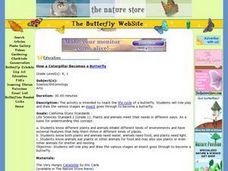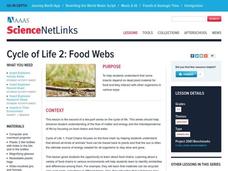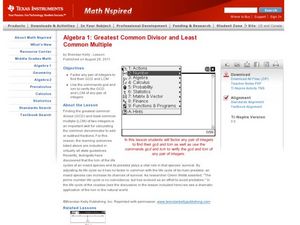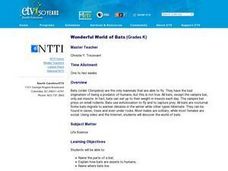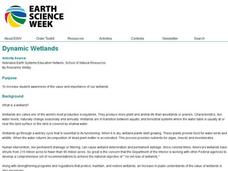Curated OER
Fly Tying
Learners practice fly tying and explain water conservation efforts in Iowa. In this ecology, Iowa geography, and natural resources lesson, students identify basic equipment and material needed to fish, then tie flies. Learners name...
Curated OER
Nutrition and Energy Flow
In this energy flow worksheet, students will complete 10 short answer questions based on a food web diagram. Then students will review different cycles in nature including the water cycle, carbon cycle, and energy cycle. This worksheet...
Curated OER
Spiders! Scary or Nice?
Students participate in a variety of cross-curriculur activities in order to explore spiders.
Curated OER
Signs of the Seasons
Students closely observe the natural world, record data, and notice patterns as the seasons unfold, they build a deeper understanding of seasonal change! The definition of phonology is the focus of this activity and how it changes...
Curated OER
How a Caterpillar Becomes a Butterfly
Student role play and draw the various stages an insect goes through to become a butterfly. They discover the different stages of how a caterpillar becomes a butterfly. Students read The Very Hungry Caterpilla by Eric Carle.
Curated OER
The Trial of the Bloody Sucker
Students study creatures that drink blood. In this blood suckers lessons, students watch videos to learn about creatures that drink blood. Students divide into groups and make posters about the organisms. Students then participate in a...
Curated OER
Organic and Inorganic Waste
Students conduct a scientific investigation about organic or inorganic waste. For this organic or inorganic waste lesson, students create a compost heap to determine the difference between inorganic and organic waste. Students record...
SeaWorld
Animal Migrations
Here is a fabulous set of activities for your young scientists. Each instructional activity contains map, hands-on, and game activities that will help the class understand why and how animals migrate from one place to another. First...
California Academy of Science
Composting: A Scientific Investigation: California Academy of Sciences
Garbage, recycle, compost: Does it really matter where we put our trash once we are done? By making detailed observations over seven weeks, kids will see which materials break down naturally to become a healthy part of the soil, and...
EngageNY
Conducting Research: Asking and Answering our Questions about Rainforest Arthropods
Let's ask an expert. Scholars divide into groups to research and become experts on either ants or butterflies. Learners use task cards and text on their topic to complete a note catcher. At the end, they share their information with a...
Curated OER
School Forest
Sixth graders explore the concept of biodiversity. In this biodiversity lesson, 6th graders discover a variety of planets and animals that live in forests, and how a rotting log benefits that environment. Students also locate seven...
University of Wisconsin
Identifying Your Soil for Rain Gardens
Teach your class the descriptive characteristics of soil. Provide information about particle size and a flow chart for assessing texture. Soil scientists then analyze samples and hypothesize which would be the best type for a rain...
ARKive
Butterflies and Blooms
The Northwoods of Wisconsin are lovely in the summer,and they are also home to many flower and butterfly species. Investigate the ways in which seasonal flowers and butterflies are interdependent on each other for survival with a fun...
Curated OER
Prairie Scales and Prairie Smoothies
Sixth graders explore the animals that live on the prairie and identify differences between amphibians and reptiles and the adaptations each have made to live on the prairie.
Curated OER
Where Are the Dinosaurs?
Students examine the concept of extinction by studying dinosaurs. For this living environment lesson, students view dinosaur video clips and define the word "extinction." Students visit the "Zoom Dinosaur" website to investigate various...
Texas Instruments
Greatest Common Divisor and Least Common Multiple
Students solve problems using the GCD and LCM. In this algebra lesson, students factor and simplify equations using the greatest common and least common factors and multiples. They factor integers in pairs.
Curated OER
Creating a Food Web
Students investigate hunters and prey by creating a food web. In this animal life lesson, students investigate a single organism in preparation for a field trip, discovering its diet and habitat. Students each discuss their animal with...
Curated OER
Wonderful World of Bats
Students create a book about bats. They write a letter to a scientist containing questions about bats. They compare the socialization of bats to humans; compare the needs of bats to humans and other animals.
Curated OER
Dynamic Wetlands
Students construct and observe a model of two different types of wetlands. In this wetlands lesson, students create a model of a wetland with constant drainage and a wetland that maintains a well-saturated soil. Students observe and...
Curated OER
Invertebrates
For this invertebrate worksheet, students review characteristics of the different types of invertebrates. This worksheet places 32 vocabulary words into a crossword puzzle.
Curated OER
Mutualism and Co-evolution A study of Flowering Plants and their Pollinators: Biology, Plants
These lessons use a variety of methods and approaches to teach flowering plant biology which includes seed germination; plant growth and food production through photosynthesis; plant transpiration and respiration; sexual reproduction...
Curated OER
Hide In Plain Sight
Students view video clips and use the Internet to look for hidden animals. They then use the Internet to print out animal shapes and color them. They create environments on construction paper in which their animals can hide.
Curated OER
Mealworm Metamorphosis
Students observe offspring (mealworms) that do not initially resemble their parent organism (darkling beetles) throughout complete metamorphosis. They also create and maintain an appropriate habitat for the mealworms.
Curated OER
CONNECTIONS
Learners study the interdependence of an ecosystem that allows it to sustain itself. They examine the Western lowland gorillas for an example.






